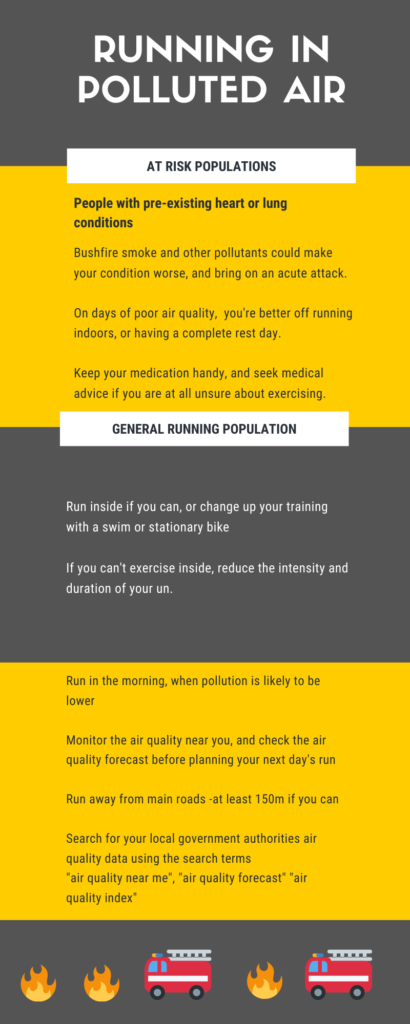
Bush fire smoke can cause major health issues.
Edit- 15/01/2020: I can hardly believe some two months after writing this article concerns about air quality in eastern parts of Australia are still relevant. When I published this article, I did not expect that days of poor air quality would turn into weeks and months. The acting Chief Medical Officer of Australia, Professor Paul Kelly, had this to say about it on January 10th 2020. “I think what we do know at the moment – and this is very good news – is for those places where the return to normal very good air quality is likely to be the case, that the effects of bushfire smoke on health are reversible in those situations”
I think what we do know at the moment – and this is very good news – is for those places where the return to normal very good air quality is likely to be the case, that the effects of bushfire smoke on health are reversible in those situations.
In the healthy population bush fire smoke and other pollution can cause:
- Respiratory symptoms – it may feel harder to breath in a smokey environment
- Temporary reduction in lung function
- Inflammation of the respiratory system
- Itchy or stinging eyes
- Sore throat
- Nausea
Those people higher risk include:
- People with existing heart or lung conditions such as asthma and emphysema, chronic obstructive pulmonary disease, and chronic bronchitis
- Pregnant women
- Older people
- Young children
Why does bush fire smoke effect us?
Bush fire smoke (and other pollution) contains fine particulate matter with diameters less than 2.5 micrometers (PM2.5). It also contains other contaminants which are less likely to affect you if you are away from the immediate surrounds of the fire.
This particulate matter is so small that the individual particles are not visible to the naked eye -in fact they are about 1/30th of the width of an average human hair. They can bury themselves deep down into the lungs, and also enter the bloodstream. This can cause inflammation, and issues with circulation. With short term exposure, these effects appear to be temporary. “Healthy adults generally find that any symptoms they have developed during a bush fire event clear after the smoke disappears.” (1)
The impact of bush fire smoke is especially relevant to runners. We rely on lungs which function well!
When you exercise, you inhale at a much faster rate than when you are at rest. Your tidal volume (the amount of air you breath in per breath) can increase from 0.4 L to 1 litre at rest, to 3 litres during aerobic exercise.
That’s a lot more air you’re taking in when you’re exercising, and if you’re exercising when there’s smoke about, a lot more PM2.5’s you’re sucking up.
Apart from taking in more air, you’re also most likely breathing through your mouth rather than your nose when you’re running, so you’re bypassing the nasal hairs which will filter out some of the particulates.
Runners can have symptoms such as chest tightness and shortness of breath, which can reduce their ability to get air in and out efficiently.
Other Pollutants
Bush fires will also increase the Ozone levels (O3). O3 is also produced at ground level when exhaust from cars mixes with direct sunlight. It is often responsible for coughing, wheezing, headaches, nausea, and eye and throat irritation. Ozone concentration is at its highest in the summer (pretty much the same time we’re likely to experience a bush fire so you get a double whammy) and during high-traffic times of the day.
Your cardiovascular system is less efficient in pollution. Carbon monoxide (CO) is the most detrimental pollutant in this respect. Oxygen is transported to the muscles by bonding to haemoglobin. Four oxygen molecules bond to each molecule of haemoglobin.
The affinity between carbon monoxide and haemoglobin is 210 times greater than the affinity between oxygen and haemoglobin (2) , so when carbon monoxide is present, the haemoglobin will prefer to bond to carbon monoxide It impairs performance by bonding with hemoglobin and preventing oxygen from reaching muscles. As much as 5 per cent of red blood cells can be flooded with carbon monoxide in heavy smog, which leaves fewer cells to transport oxygen. Carbon monoxide is not generally found in high concentrations in bush fire smoke. It’s more prevalent in the air beside busy roads.
Will running in polluted air effect me long term?
Yes – but not as you might expect.
Some of our runners have reported nausea and respiratory issues when they’ve been running under smokey conditions, and it stands to reason that if you can avoid running outside when the smoke is thick in the air, you should.
Given the short term detrimental health effects of exercising on days of high pollution, you might expect that if you regularly exercise in areas of high pollution, it would adversely affect your health long term. Some studies indicate this is not the case however.
Some of the benefits of running counteract the adverse effects of air pollution. Air pollution causes oxidative stress, which reduces the body’s ability to keep toxins at bay and also causes inflammation of the lungs. Aerobic exercise reduces oxidative stress, and also to combats inflammation.
Some of the benefits of running counteract the adverse effects of air pollution
There are a couple of studies that demonstrate that, on a long term basis, if your choice is between exercising in polluted air, and not exercising at all, you should exercise (providing you are healthy, and not in a high risk group with respiratory or heart problems).
A study in Brazil, published in Medicine and Science in Sports and Exercise (3) looked at the effects of long term aerobic exercise on the lungs’ response to diesel exhaust particulates. The study was conducted on four groups of mice:
- A sedentary group who did nothing
- An exercise group that trained five times a week
- A group that was sedentary and inhaled diesel exhaust particles
- A group that trained five times a week, and inhaled diesel exhaust particulates
The results found:
- The highest levels of oxidative stress among the mice who didn’t exercise and were exposed to pollutants.
- The levels of oxidative stress in the other three groups didn’t change significantly.
- There was no difference in oxidative stress levels between the mice that exercised whilst inhaling polluted air, and those who exercised in fresh air.
The researchers concluded that the running protected the mice from the damaging effects of pollution.
A study on people
A Danish study published in 2015, confirms that long term, the benefits of exercising outweigh the negative effects of exercising in polluted conditions. The study looked at data from more than 52,000 people, (yes, people, not mice) and found that “over the long-term, exposure to air pollution while exercising did not seem to reduce the beneficial health effects of physical activity on mortality risk.”(4)
The researchers were expecting that the small damages to the heart and lungs which were shown in short term studies would accumulate over time and reduce some of the beneficial effects of exercise. But, they found the opposite.
Lead author of the study Zorana Jovanovic Andersen says exercise seemed to offer a protective effect. And get this, even those study participants with a high exposure to air pollution showed a reduced risk of overall mortality by 25%. “So we think that the damages [to heart and lungs] are probably transitional,” she says, “and maybe they are improved by exercise.”
On average, exercise is more likely to extend your life, than increased exposure to pollution will shorten it.
On average, exercise is more likely to extend your life, than increased exposure to pollution will shorten it. Some low intensity running on high smoke days from time to time is probably going to do you little harm, unless you’re in a high risk population.
It’s not a smart thing to head outdoors for a hard workout when the air is thick with smoke day after day after day. Be sensible, be aware of the weather forecast and also the air pollution forecast, schedule your week so that you’re hardest workouts are either on days of low pollution, or indoors.
How can you limit the effects of high pollution when you’re exercising?
- Exercise inside if you can. Hit the gym, the indoor pool, jump on the dreadmill. It’s only short term.
- If you can’t exercise inside, try to run in the morning, when bush fire smoke and other pollutants are less likely to be hanging in the air. Night is also okay, but avoid running in the afternoon.
- Monitor the air quality near you. This link will take you to the NSW government Air Quality Index (AQI) sight. The air quality is reported as an average figure for the last 24 hours, so it’s not going to give you a reading for how the air quality is right now unfortunately. If the air quality has dropped considerably in the last few hours for example, the average figure will be skewed by the good hour in the preceding 24 hour period.
- This link will take you to the air quality forecast for the next day.
- Try to run well away from main roads to avoid high levels of particulates. We’re susceptible not only to car exhaust, but also to micro particles of tar that are liberated by the friction of car tyres on the road.
- Reduce the intensity of your run on high pollution days, but don’t increase the duration of your run. This means you can’t really swap out a speed workout for a long run. Whilst you won’t be breathing as hard during a long run as you would in a speed workout, and you therefore won’t be taking in as much air with each breath, if you run for longer, you’ll be taking more breaths in total, and most likely the same amount of air, or more!
References
(1) https://www.health.nsw.gov.au/environment/factsheets/Pages/bushfire-smoke.aspx
(2) Carbon Monoxide Poisoning. Journal of the Royal Society of Medicine https://www.ncbi.nlm.nih.gov/pmc/articles/PMC1281520/
(3) https://www.webmd.com/fitness-exercise/features/ls-running-outside-toxic#2
(4) https://www.ncbi.nlm.nih.gov/pmc/articles/PMC4455577/#r3



